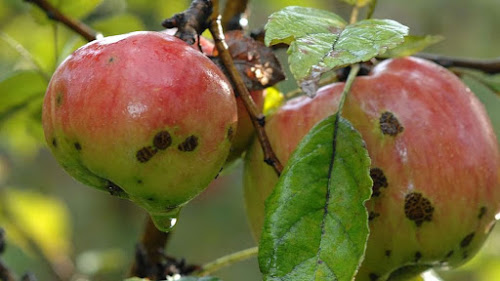Apple Scab
A serious disease of apples and ornamental crabapples, apple scab (Venturia inaequalis) attacks both leaves and fruit. The fungal disease forms pale yellow or olive-green spots on the upper surface of leaves. Dark, velvety spots may appear on the lower surface. Severely infected leaves become twisted and puckered and may drop early in the summer.
Symptoms on fruit are similar to those found on leaves. Scabby spots are sunken and tan and may have velvety spores in the center. As these spots mature, they become larger and turn brown and corky. Infected fruit becomes distorted and may crack allowing entry of secondary organisms. Severely affected fruit may drop, especially when young.
Apple scab overwinters primarily in fallen leaves and in the soil. Disease development is favored by wet, cool weather that generally occurs in spring and early summer. Fungal spores are carried by wind, rain or splashing water from the ground to flowers, leaves or fruit. During damp or rainy periods, newly opening apple leaves are extremely susceptible to infection. The longer the leaves remain wet, the more severe the infection will be. Apple scab spreads rapidly between 55-75 degrees F.
Treatment
- Choose resistant varieties when possible.
- Rake under trees and destroy infected leaves to reduce the number of fungal spores available to start the disease cycle over again next spring.
- Water in the evening or early morning hours (avoid overhead irrigation) to give the leaves time to dry out before infection can occur.
- Spread a 3- to 6-inch layer of compost under trees, keeping it away from the trunk, to cover soil and prevent splash dispersal of the fungal spores.
- For best control, spray liquid copper soap early, two weeks before symptoms normally appear. Alternatively, begin applications when disease first appears, and repeat at 7 to 10 day intervals up to blossom drop.
- Bonide® Sulfur Plant Fungicide, a finely ground wettable powder, is used in pre-blossom applications and must go on before rainy or spore discharge periods. Apply from pre-pink through cover (2 Tbsp/ gallon of water), or use in cover sprays up to the day of harvest.
- Organocide® Plant Doctor is an earth-friendly systemic fungicide that works its way through the entire plant to combat a large number of diseases on ornamentals, turf, fruit and more. Apply as a soil drench or foliar spray (3-4 tsp/ gallon of water) to prevent and attack fungal problems.
- Containing sulfur and pyrethrins, Bonide® Orchard Spray is a safe, one-hit concentrate for insect attacks and fungal problems. For best results, apply as a protective spray (2.5 oz/ gallon) early in the season. If disease, insects or wet weather are present, mix 5 oz in one gallon of water. Thoroughly spray all parts of the plant, especially new shoots.




Comments
Post a Comment